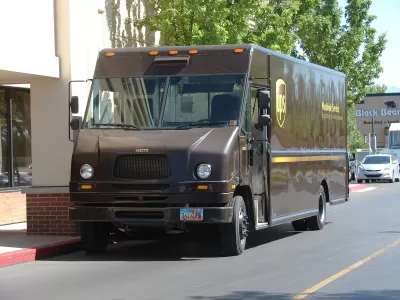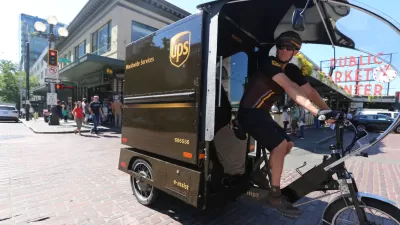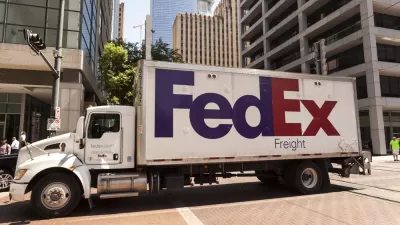How cities can minimize the impact of delivery vehicles on air quality and congestion through effective curb management and zero-emission delivery zones.

As urban delivery services become more common for a wider variety of goods and services, cities are looking at ways to cut down on the emissions and congestion caused by delivery vehicles. Writing in The City Fix, Hamilton Steimer and Vishant Kothari outline the results of a paper from the World Resources Institute (WRI) that assesses efforts to create ‘zero-emission delivery’ zones in the United States and the Netherlands.
As the article explains, “Zero-emission delivery zones are areas in which only zero-emission vehicles have unrestricted access, with fossil fuel vehicles either prohibited from entry or required to pay a fee for access.” The zones can take a variety of forms, from voluntary zones to localized pick-up locations and curbside spaces reserved for ZEVs.
The authors provide detail on the city of Los Angeles’ zero-emission commercial loading zones, which regulate curbside management in five dense areas with high demand for commercial loading and high levels of air pollution. “If expanded, zero-emission loading zones could discourage fossil fuel vehicle use in specific areas, incentivize a shift to zero-emission delivery throughout Los Angeles, and reduce residents’ exposure to air pollutants like particulate matter and nitrous oxides.”
The paper also provides five recommendations for developing and implementing zero-emission delivery zones successfully. As the authors caution, “Without proper design and implementation, zero-emission delivery zones and supportive policies could exacerbate existing inequities, such as diverting polluting freight traffic through neighborhoods outside the zone or failing to supply small businesses in the zone with the necessary financial support to purchase ZEVs.”
FULL STORY: Zero-Emission Delivery Zones: A New Way to Cut Traffic, Air Pollution and Greenhouse Gases

Planetizen Federal Action Tracker
A weekly monitor of how Trump’s orders and actions are impacting planners and planning in America.

Restaurant Patios Were a Pandemic Win — Why Were They so Hard to Keep?
Social distancing requirements and changes in travel patterns prompted cities to pilot new uses for street and sidewalk space. Then it got complicated.

Map: Where Senate Republicans Want to Sell Your Public Lands
For public land advocates, the Senate Republicans’ proposal to sell millions of acres of public land in the West is “the biggest fight of their careers.”

Maui's Vacation Rental Debate Turns Ugly
Verbal attacks, misinformation campaigns and fistfights plague a high-stakes debate to convert thousands of vacation rentals into long-term housing.

San Francisco Suspends Traffic Calming Amidst Record Deaths
Citing “a challenging fiscal landscape,” the city will cease the program on the heels of 42 traffic deaths, including 24 pedestrians.

California Homeless Arrests, Citations Spike After Ruling
An investigation reveals that anti-homeless actions increased up to 500% after Grants Pass v. Johnson — even in cities claiming no policy change.
Urban Design for Planners 1: Software Tools
This six-course series explores essential urban design concepts using open source software and equips planners with the tools they need to participate fully in the urban design process.
Planning for Universal Design
Learn the tools for implementing Universal Design in planning regulations.
Heyer Gruel & Associates PA
JM Goldson LLC
Custer County Colorado
City of Camden Redevelopment Agency
City of Astoria
Transportation Research & Education Center (TREC) at Portland State University
Camden Redevelopment Agency
City of Claremont
Municipality of Princeton (NJ)




























